Endothelial pannexin 1-TRPV4 channel signaling lowers pulmonary arterial pressure in mice
- PMID: 34490843
- PMCID: PMC8448527
- DOI: 10.7554/eLife.67777
Endothelial pannexin 1-TRPV4 channel signaling lowers pulmonary arterial pressure in mice
Abstract
Pannexin 1 (Panx1), an ATP-efflux pathway, has been linked with inflammation in pulmonary capillaries. However, the physiological roles of endothelial Panx1 in the pulmonary vasculature are unknown. Endothelial transient receptor potential vanilloid 4 (TRPV4) channels lower pulmonary artery (PA) contractility and exogenous ATP activates endothelial TRPV4 channels. We hypothesized that endothelial Panx1-ATP-TRPV4 channel signaling promotes vasodilation and lowers pulmonary arterial pressure (PAP). Endothelial, but not smooth muscle, knockout of Panx1 increased PA contractility and raised PAP in mice. Flow/shear stress increased ATP efflux through endothelial Panx1 in PAs. Panx1-effluxed extracellular ATP signaled through purinergic P2Y2 receptor (P2Y2R) to activate protein kinase Cα (PKCα), which in turn activated endothelial TRPV4 channels. Finally, caveolin-1 provided a signaling scaffold for endothelial Panx1, P2Y2R, PKCα, and TRPV4 channels in PAs, promoting their spatial proximity and enabling signaling interactions. These results indicate that endothelial Panx1-P2Y2R-TRPV4 channel signaling, facilitated by caveolin-1, reduces PA contractility and lowers PAP in mice.
Keywords: Caveolin 1; Pannexin 1; TRP channel; biochemistry; cell biology; chemical biology; mouse; pulmonary vasculature; purinergic signaling.
© 2021, Daneva et al.
Conflict of interest statement
ZD, YC, EK, MK, SS, RM, CS, VL, BI, SS none, MO None
Figures
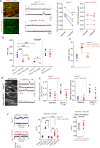


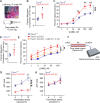
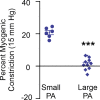


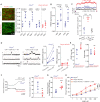



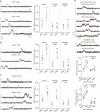


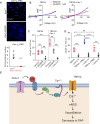
Similar articles
-
Purinergic P2Y2 receptor-induced activation of endothelial TRPV4 channels mediates lung ischemia-reperfusion injury.Sci Signal. 2023 Oct 24;16(808):eadg1553. doi: 10.1126/scisignal.adg1553. Epub 2023 Oct 24. Sci Signal. 2023. PMID: 37874885 Free PMC article.
-
Pannexin 1: a novel regulator of acute hypoxic pulmonary vasoconstriction.Cardiovasc Res. 2022 Aug 24;118(11):2535-2547. doi: 10.1093/cvr/cvab326. Cardiovasc Res. 2022. PMID: 34668529 Free PMC article.
-
Purinergic P2Y2 Receptor-Induced Activation of Endothelial TRPV4 Channels Mediates Lung Ischemia-Reperfusion Injury.bioRxiv [Preprint]. 2023 May 31:2023.05.29.542520. doi: 10.1101/2023.05.29.542520. bioRxiv. 2023. Update in: Sci Signal. 2023 Oct 24;16(808):eadg1553. doi: 10.1126/scisignal.adg1553. PMID: 37397979 Free PMC article. Updated. Preprint.
-
Emerging concepts regarding pannexin 1 in the vasculature.Biochem Soc Trans. 2015 Jun;43(3):495-501. doi: 10.1042/BST20150045. Biochem Soc Trans. 2015. PMID: 26009197 Free PMC article. Review.
-
Intrinsic properties and regulation of Pannexin 1 channel.Channels (Austin). 2014;8(2):103-9. doi: 10.4161/chan.27545. Epub 2014 Jan 13. Channels (Austin). 2014. PMID: 24419036 Free PMC article. Review.
Cited by
-
Vascular mechanotransduction.Physiol Rev. 2023 Apr 1;103(2):1247-1421. doi: 10.1152/physrev.00053.2021. Epub 2023 Jan 5. Physiol Rev. 2023. PMID: 36603156 Free PMC article. Review.
-
Multifaceted Role of Notch Signaling in Vascular Health and Diseases.Biomedicines. 2025 Mar 31;13(4):837. doi: 10.3390/biomedicines13040837. Biomedicines. 2025. PMID: 40299408 Free PMC article. Review.
-
Small-world connectivity dictates collective endothelial cell signaling.Proc Natl Acad Sci U S A. 2022 May 3;119(18):e2118927119. doi: 10.1073/pnas.2118927119. Epub 2022 Apr 28. Proc Natl Acad Sci U S A. 2022. PMID: 35482920 Free PMC article.
-
The Variety of Mechanosensitive Ion Channels in Retinal Neurons.Int J Mol Sci. 2024 Apr 30;25(9):4877. doi: 10.3390/ijms25094877. Int J Mol Sci. 2024. PMID: 38732096 Free PMC article. Review.
-
Imaging Ca2+ Signals in Small Pulmonary Veins at Physiological Intraluminal Pressures.J Vis Exp. 2025 Mar 21;(217):10.3791/67722. doi: 10.3791/67722. J Vis Exp. 2025. PMID: 40193310 Free PMC article.
References
-
- Bakhshi FR, Mao M, Shajahan AN, Piegeler T, Chen Z, Chernaya O, Sharma T, Elliott WM, Szulcek R, Bogaard HJ, Comhair S, Erzurum S, van Nieuw Amerongen GP, Bonini MG, Minshall RD. Nitrosation-dependent caveolin 1 phosphorylation, ubiquitination, and degradation and its association with idiopathic pulmonary arterial hypertension. Pulmonary Circulation. 2013;3:816–830. doi: 10.1086/674753. - DOI - PMC - PubMed
Publication types
MeSH terms
Substances
Grants and funding
LinkOut - more resources
Full Text Sources
Molecular Biology Databases
Research Materials

